A new(?) consideration in choosing Manual vs some kind of auto
Oct 23, 2018 10:28:10 #
I sincerely regret some of the remarks in reference to your post. I find your post very interesting and reinforces my idea that automation is not that bad after all. There it seems at times to have more precision than when we do or try to control the camera.
I shoot in aperture priority often but I do not neglect manual mode which has been my shooting mode for many years, especially for landscapes. I have never experimented but like you I have noticed similar results to your experiments.
I want to thank you for the courtesy of offering that information to us.
I shoot in aperture priority often but I do not neglect manual mode which has been my shooting mode for many years, especially for landscapes. I have never experimented but like you I have noticed similar results to your experiments.
I want to thank you for the courtesy of offering that information to us.
Oct 23, 2018 11:11:37 #
I was going to leave a comment but you are right, if it isn't of interest then move along. Something we should be doing with all posts instead of tearing apart the poster. There are many detail oriented people on the forum that might benefit.
Oct 23, 2018 12:13:41 #
As a professional photographer, I routinely test new equipmet as it is added to my inventory and periodically test older gear, especially if I suspect a malfunction on an impending issue in the offing. In my work, oftentimes I have redundant gear to be used as spares in the event of some kind of breakdown. I have had camera bodies, lenses and electronic flas equipment of the same type and make, purchased at the same times and on a few cases only one serial number apartn showed discrepancies in performance and accuracy. This was more frequent with older technologies with more mechanical than electronic workings. Nowadays this is less prevalent but there are still some anomalies.
Not being an engineer or repair technician, I would sometimes refer theses issues to the manufacturers representatives or my repair folks. The issue of shutter vs. aperture exposure variation was explained an intrinsic problem with some cameras and systems, This is because the shutter is electronically timed is more precise than a diaphragm in the lens which is controlled by a longer chain of mechanisms, perhaps servo type systems which may be less precise or consistant for lens to lens. When you change lenses, especially ones of different types, makes and ages, the problem may be exacerbated.
In actual use in the field, I have not found much of this problematic. Once the tests are performed and any extreme malfunction or discrepancies are repaired, slight differences are usually easily compensated for by exposure bracketing and post processing manipulations- usually very slight.
As practitioners of the zone system understand, even with handheld external meters, or precise spot meters, the actual zone from which the light reading is collected is critical to the system. In may current camera systems, there is a plethora of metering options so it is difficult to pin down an exposure issue unless you take full control over the system by making spot readings, locking in exposure and recomposing the image. Not exactly something that can be done in may kind s of wildlife photography. The method there is to fully understand your camera/lens combinations idiosyncrasies and operate accordingly. Therein lies the value of testing.
Of course, in the olden (film) days, the zone system entailed purposely over and underexposing and altering development to control dynamic range and contrasts. My first foray into zone system land was a calls where the instructor had each of us determine specific (ASA) ISO rating for each of our own cameras, lenses, and favorite film. The manufacturer's rating were only considered starting points.
My testing is strictly to determine accuracy but more in the area of consistency in each piece of gear, simply stated, I just need to know if the stuff is working within reasonable tolerances so there would be no serious issues on various assignments. In actual practice there are too many variables to factor into a test made in a studio or laboratory environment. The subject, existing lighting conditions and working circumstances are not necessarily even near the same as a test target and setup. The angle of incidence can affect brightness- light striking the subject at various angles can show the same meter reading and yet the source at a greater angle to the camera/subject axis will register as brighter. Meters can be influenced differently by various colors.
In professional work, at the end of the day, testing is cost effective and worth the time. Maintaining accurate exposure cuts down on lengthy and tedious post processing time that is required to compensate for radical errors. If certain problems do occur, at least we know the equipment is not at fault and the troubleshooting needs to be directed at the technique. I don't believe in sloppy or haphazard shooting and hours of remedial work at the computer (formerly in the darkroom). More accurate shooting makes for easier workflow, production, prompt delivery and better quality. Many professional assignments can not be re-staged or re-shot. Fortunately, in digital photography, what with instantaneous monitoring and possibility of computer tethering it is unlikely that one can lave a site or a location without usable images. Even if the image on the camera's LCD screen is not 100% accurate or easily readable, experienced users know how to interpret the data and know what to expect in the final processed result.
Not being an engineer or repair technician, I would sometimes refer theses issues to the manufacturers representatives or my repair folks. The issue of shutter vs. aperture exposure variation was explained an intrinsic problem with some cameras and systems, This is because the shutter is electronically timed is more precise than a diaphragm in the lens which is controlled by a longer chain of mechanisms, perhaps servo type systems which may be less precise or consistant for lens to lens. When you change lenses, especially ones of different types, makes and ages, the problem may be exacerbated.
In actual use in the field, I have not found much of this problematic. Once the tests are performed and any extreme malfunction or discrepancies are repaired, slight differences are usually easily compensated for by exposure bracketing and post processing manipulations- usually very slight.
As practitioners of the zone system understand, even with handheld external meters, or precise spot meters, the actual zone from which the light reading is collected is critical to the system. In may current camera systems, there is a plethora of metering options so it is difficult to pin down an exposure issue unless you take full control over the system by making spot readings, locking in exposure and recomposing the image. Not exactly something that can be done in may kind s of wildlife photography. The method there is to fully understand your camera/lens combinations idiosyncrasies and operate accordingly. Therein lies the value of testing.
Of course, in the olden (film) days, the zone system entailed purposely over and underexposing and altering development to control dynamic range and contrasts. My first foray into zone system land was a calls where the instructor had each of us determine specific (ASA) ISO rating for each of our own cameras, lenses, and favorite film. The manufacturer's rating were only considered starting points.
My testing is strictly to determine accuracy but more in the area of consistency in each piece of gear, simply stated, I just need to know if the stuff is working within reasonable tolerances so there would be no serious issues on various assignments. In actual practice there are too many variables to factor into a test made in a studio or laboratory environment. The subject, existing lighting conditions and working circumstances are not necessarily even near the same as a test target and setup. The angle of incidence can affect brightness- light striking the subject at various angles can show the same meter reading and yet the source at a greater angle to the camera/subject axis will register as brighter. Meters can be influenced differently by various colors.
In professional work, at the end of the day, testing is cost effective and worth the time. Maintaining accurate exposure cuts down on lengthy and tedious post processing time that is required to compensate for radical errors. If certain problems do occur, at least we know the equipment is not at fault and the troubleshooting needs to be directed at the technique. I don't believe in sloppy or haphazard shooting and hours of remedial work at the computer (formerly in the darkroom). More accurate shooting makes for easier workflow, production, prompt delivery and better quality. Many professional assignments can not be re-staged or re-shot. Fortunately, in digital photography, what with instantaneous monitoring and possibility of computer tethering it is unlikely that one can lave a site or a location without usable images. Even if the image on the camera's LCD screen is not 100% accurate or easily readable, experienced users know how to interpret the data and know what to expect in the final processed result.
Oct 23, 2018 12:20:03 #
a6k wrote:
If you are not a perfectionist or close to it then... (show quote)
There was a time when I was teaching photography at a university that we did testing as part of class work. Of more importance in that day was how accurate the mechanical shutter was and how close to the numbered f-stop each lens was. Most in camera exposure meters were not that good in low light. Some had memory problems in bright light. Film had it's variables too. Age, temperature extreams, and of course "batch" and processing varied the outcome. Lots and lots of variations in those days.
Today's equipment is very very good, reliable and consistent in its results. I see no need to go to the extent of testing that you are doing, other than to say , Yes it all works as designed. All the camera manufacturers do a very extensive testing of each camera and lens prior to shipping it out. Rearely does something go wrong in shipping but it does happen. With live view that our Sony cameras have as well as other mirrorless cameras, what you see is what you get. Being an artist, I shoot and adjust the image as I like it not to what scales, numbers, charts, and histograms say it should be. That to me is the difference between a technician and a photographer.
Oct 23, 2018 13:56:51 #
a6k wrote:
If you are not a perfectionist or close to it then... (show quote)
** Not to be unkind, but you might consider contemplating your navel as a much more
productive activity. Seriously, if this kind of experiment is your thing, go for it. I wouldn't,
however, expect many sympathetic responses here, as you have seen already. In particular,
anyone concerning themselves with the impact on exposure of 1/6 stop has way too much
time on their hands and needs to get out more. >Alan
Oct 23, 2018 14:43:40 #
To the OP! Please continue doing what you're doing. Few people care about what you do but that shouldn't stop what you're doing.
Oct 23, 2018 14:47:28 #
a6k
Loc: Detroit & Sanibel
Architect1776 wrote:
...and a very slight tweak in PS or your favorite program can make final adjustments.
So now you know this information how will you apply it to real world pictures that you take?
..... How does what you learned apply to the various situations at 1/6 stop?
So now you know this information how will you apply it to real world pictures that you take?
..... How does what you learned apply to the various situations at 1/6 stop?
If you are not "anal" (a horrible, ugly misuse of layman's psycho-babble) but really want to get the picture as good as you can, then putting the original values in the right place is arguably better than post-processing. PP is fine; I do it with almost every picture. But if you start with the best that you can do, then you are trying for the final result being the best that you can do.
Actually, my purpose in doing the tests was and remains to understand where on the gray scale the meter is trying to put everything. Discovering that the camera can control itself in a continuum as opposed to a series of discrete steps worth 1/3 stop each was just interesting and thus shareable. It gives me an easy way to improve the precision of the exposure.
How does this apply? Well whether it's 1/6 of a stop or some other amount, I want to know with some certainty how far to the right I can expose without diminishing the quality of the image. That is what the testing is about. Using the Zebra setting on the camera is a practical way to instantly analyze that aspect of a scene, even wildlife unless perhaps BIF's, etc.
I said all this already but since you asked the question I decided to help you understand the answer a little better.
Oct 23, 2018 14:56:25 #
a6k
Loc: Detroit & Sanibel
ORpilot wrote:
There was a time when I was teaching photography a... (show quote)
This is not the first or even among the few times that UHHers have used the contrast between technician and artist (AKA photographer) as a criticism. I've yet to understand why you or they think that mastering the tool diminishes the art. I make no claims to being a very good artist but I usually get pleasing reactions from the folks with whom I share my pics.
As for the quality and repeatability of today's equipment, I agree. However you are overlooking that a Sony vs a Nikon vs a Canon vs a Fuji (and, of course, various models and sensor sizes) can be quite different from each other and the stuff that I'm testing and measuring is not well documented, if at all. I have yet to see an ad or user manual from any of them that tells you the things that individual camera testing can reveal. I well remember the camera magazines and the tests for shutter speed and lens opening accuracy. I also remember working very hard to have complete repeatability in my film development process. Those skills served me well when I later managed a microfilm operation for a major company. The documents we filmed were business-important so getting the processes "right" had real economic value and mattered to the people who depended on us to preserve their records.
Oct 23, 2018 15:02:50 #
With apologies to the detractors, FWIW, Nikon does the same thing. If the camera is in control of the shutter / ISO, it can use 1/6th stops, the operator is limited to 1/3rd stops. However, there is so much latitude in today's RAW files that it doesn't really matter since above base ISO it's all signal amplification anyway. With super-low read noise, we can underexpose by upwards of 5 stops and still use the exposure slider in Lightroom to dial in a proper amount of brightness in 20th of a stop increments that would look identical to what the camera would have done on it's own (in most cases).
Oct 23, 2018 15:39:15 #
a6k
Loc: Detroit & Sanibel
For those who think that modern cameras and applications are not worth checking on, I offer these screen captures of the same file, exposed on "auto", viewed in various ways on various apps. Including that I've shown the Mac OS application for looking at color, there are 5. Some differences are small but some are not.
Note that while the camera should be placing the target as "middle gray" which is properly either 50 in CIE L* or 119 in RGB, these are mostly well above that. However, RawDigger shows a lot of headroom anyhow - more than the camera admitted to. FastRawViewer shows a lower set of values.
Note, also, that some applications show different levels for different colors while some somehow merge them into a single value or extremely close set of values. The reality is well known that the original values as recorded in the file are quite different and there are two greens for each red plus blue (4 sensors to a pixel).
Just to clarify, when I looked at the entire series in this group which were shot at various target light levels on full auto, the outcomes were very, very close. The problem, if there is one, is not one of repeatability in the camera.
No, not art. But then neither is it simple nor as advertised.
Note that while the camera should be placing the target as "middle gray" which is properly either 50 in CIE L* or 119 in RGB, these are mostly well above that. However, RawDigger shows a lot of headroom anyhow - more than the camera admitted to. FastRawViewer shows a lower set of values.
Note, also, that some applications show different levels for different colors while some somehow merge them into a single value or extremely close set of values. The reality is well known that the original values as recorded in the file are quite different and there are two greens for each red plus blue (4 sensors to a pixel).
Just to clarify, when I looked at the entire series in this group which were shot at various target light levels on full auto, the outcomes were very, very close. The problem, if there is one, is not one of repeatability in the camera.
No, not art. But then neither is it simple nor as advertised.
RawDigger
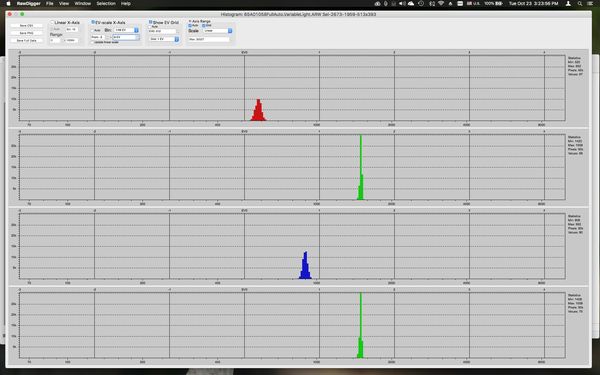
RawPhotoProcessor
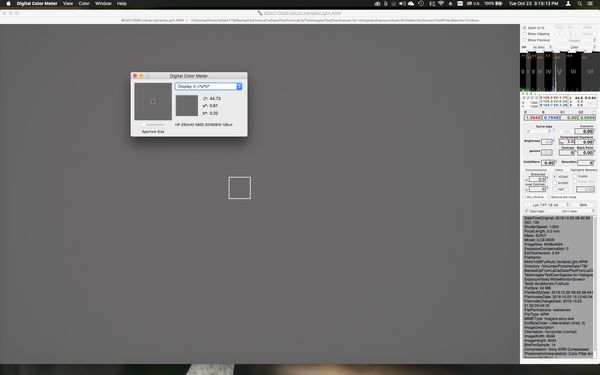
Sony Edit
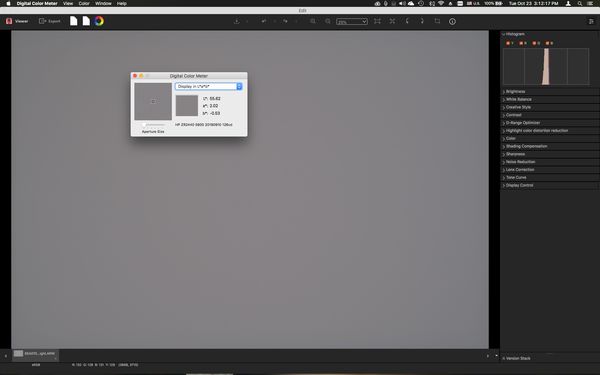
CaptureOne (Sony) Pro
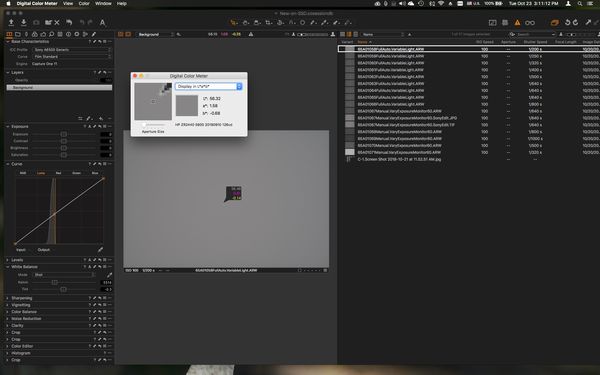
FastRawViewer
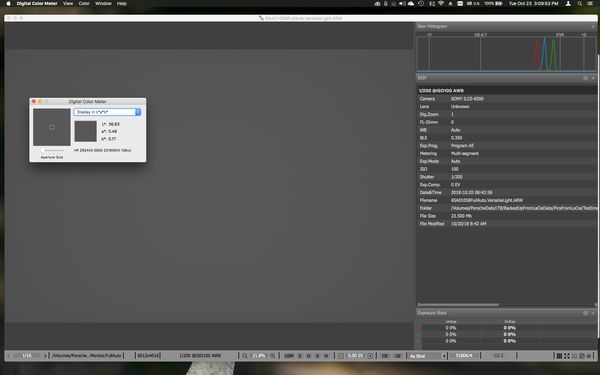
Oct 23, 2018 16:37:48 #
Not intended as criticism, The world needs technicians as well as artists. Every once in a while they are both. All that really matters is that the shooter gets the end image results that they are happy with.
Oct 23, 2018 17:18:26 #
a6k wrote:
If you are not a perfectionist or close to it then the stuff below will not be worth your time.😇...
You are not as crazy as some may have implied, but maybe that't just my viewpoint since I also do a lot of testing.
A computer screen (especially if it is calibrated) is an excellent basis for testing film, meters and lenses. But if you use it for testing digital exposure it may be a bit of overkill. I have used my calibrated computer screen when researching A Practical Guide to Film Characteristic Curves and Film vs. Digital Characteristic Curves.
I have not found any issues with electronically controlled shutters but some of the mechanical shutters on older film cameras don't quite reach the fastest one or two stops.
I have seen up to a 1/3 stop difference in light transmission in some of my prime lenses. My Leica and Voigtlander lenses are about 1/3 stop brighter and the two zoom lenses I have checked are about 1/3 stop darker. This really only matters when shooting film.
I have two light meters that can be calibrated and two that cannot. I now have them all reporting the same exposure value and they agree with each other and my camera meters to within +/-1/6 stop.
In daylight I normally forego metering altogether and rely on Sunny 16 and exposure adjustments from experience.
For digital work the need for precision is not as critical since it's so easy to adjust exposure on the spot by chimping. Besides, my digital cameras (Df, D610 and A7II) have plenty of exposure latitude.
I find that shutter speeds and meters are just as precise in Manual mode as in Aperture priority so I usually use Manual.
Oct 23, 2018 20:39:55 #
I will never understand why some folks don't or can't realize that each of us are entitled to enjoy various aspects of photography to the own liking, leanings and interests.
Even for the artistically and creatively inclined, there is no logical reason for not delving into some of the technology and drilling down a little deeper rather than just being an "appliance operator". There is nothing wrong with understanding how the tools and material of your art/craft work. This can help in troubleshooting technical problems-avoiding them in the first place and maintaining your equipment.
Every day, right here on this forum, folks are asking questions, trying to solve problems and expressing all kinds of consternation and frustration about their technical conundrums and it turns out, at the end of the conversation, that they simply don't know exactly how to operate their equipmet and how it works. Other folks complain about their disappointment in poor results in their once-in-a-lifetime vacation photos that were lost or compromised by some technical glitch in their gear- perhas something that some pre-testing would have prevented. Experimentation bring on discovery, knowledge, insight and many other rewards
Many folks, also around theses parts, are insistently going on about upgrading their cameras and lenses, parroting all the scuttlebutt and singing the praises of all the latest and greatest gear, mostly based on advertised claims, write-ups in what's left of the photo press or pontifications by online mavens. So...what's wrong with running some controlled tests or experiments with your own gear to find out what it is actually capable of and getting all your ducks lined up before going out and shooting something important or investing in more gear.
On the othere side of the argument, there are folks who could not care less about the innards of there gear or any technicalities whatsoever and still, through the miracle of automation, are making perfectly fine images based on there visual talent. Nothin' wrong with that!
At the end of the day, everyone is entitled to do their own thing, so why criticize or deride the other person's approach or enjoyment. If a post or opinion does not interest you, why not simply skip it and go on to some other more exciting topic and weigh in on prognosticating on the demise of the DSLR at the hands of the mirrorless camera- NOW-THAT'S TRENDING!
My own philosophy about photography; much of photography is problem solving and the more you know the better off you are...as a photographer.
Even for the artistically and creatively inclined, there is no logical reason for not delving into some of the technology and drilling down a little deeper rather than just being an "appliance operator". There is nothing wrong with understanding how the tools and material of your art/craft work. This can help in troubleshooting technical problems-avoiding them in the first place and maintaining your equipment.
Every day, right here on this forum, folks are asking questions, trying to solve problems and expressing all kinds of consternation and frustration about their technical conundrums and it turns out, at the end of the conversation, that they simply don't know exactly how to operate their equipmet and how it works. Other folks complain about their disappointment in poor results in their once-in-a-lifetime vacation photos that were lost or compromised by some technical glitch in their gear- perhas something that some pre-testing would have prevented. Experimentation bring on discovery, knowledge, insight and many other rewards
Many folks, also around theses parts, are insistently going on about upgrading their cameras and lenses, parroting all the scuttlebutt and singing the praises of all the latest and greatest gear, mostly based on advertised claims, write-ups in what's left of the photo press or pontifications by online mavens. So...what's wrong with running some controlled tests or experiments with your own gear to find out what it is actually capable of and getting all your ducks lined up before going out and shooting something important or investing in more gear.
On the othere side of the argument, there are folks who could not care less about the innards of there gear or any technicalities whatsoever and still, through the miracle of automation, are making perfectly fine images based on there visual talent. Nothin' wrong with that!
At the end of the day, everyone is entitled to do their own thing, so why criticize or deride the other person's approach or enjoyment. If a post or opinion does not interest you, why not simply skip it and go on to some other more exciting topic and weigh in on prognosticating on the demise of the DSLR at the hands of the mirrorless camera- NOW-THAT'S TRENDING!
My own philosophy about photography; much of photography is problem solving and the more you know the better off you are...as a photographer.
Oct 23, 2018 22:24:44 #
aubreybogle
Loc: Albuquerque, NM
E.L.. Shapiro wrote:
I will never understand why some folks don't or ca... (show quote)
Totally agree. "Knowledge for knowledge's sake" has real value, and OP's work goes far beyond that.
Oct 24, 2018 07:51:16 #
My concern with this approach is that over analyzing a thing can lead to analysis paralysis. A 1/6 stop refinement has less of an effect than a thin cloud passing in front of the sun. Again, if you are doing studio work where everything is controlled, there might be some limited value to this information. But in the rest of the world, making adjustments for minor changes in conditions comes not from controlled experiments but from practice shooting in uncontrolled settings. If the doing of the experiment improves your feel for making these changes in the field, more power to you. For me it would result in slowing down the process of shooting. And getting or not getting the shot is all about time.
If you want to reply, then register here. Registration is free and your account is created instantly, so you can post right away.








